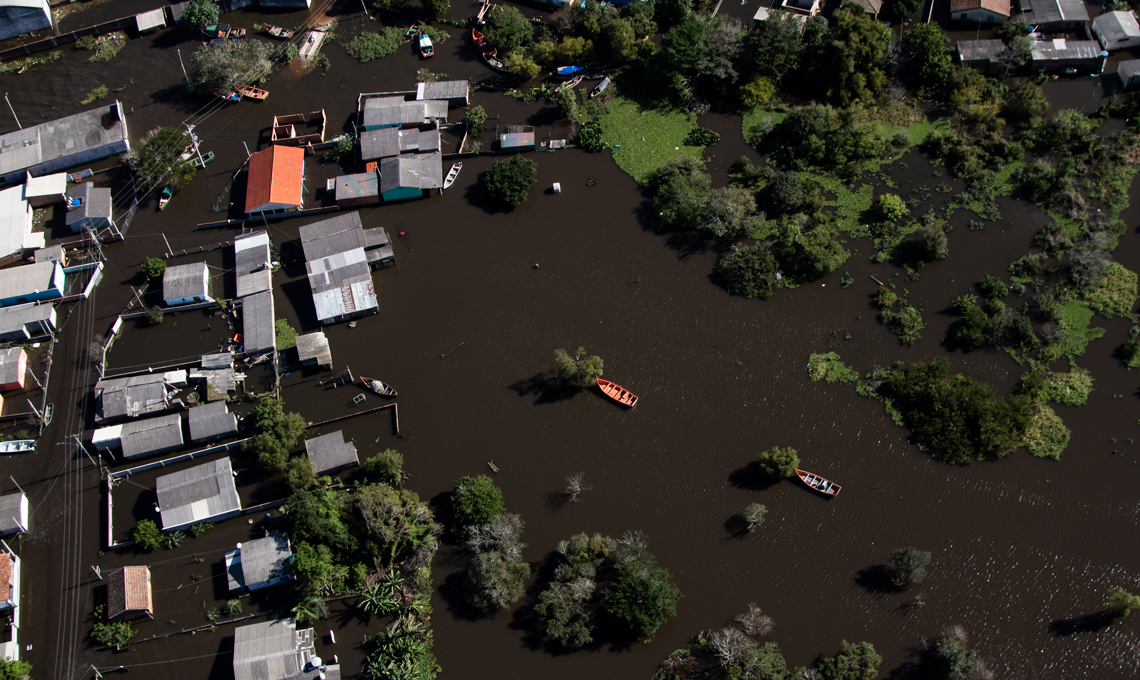A study coordinated by researchers from Imperial College London in the UK, coauthored by two Brazilians, has concluded that climate change induced by human activity and the natural phenomenon El Niño (above-average warming of waters in the central and eastern equatorial Pacific Ocean) made the extreme rainfall in Rio Grande do Sul State between the end of April and beginning of May more intense and frequent.
According to the study, published in a 56-page scientific report in June, global warming alone drove up accumulated rainfall in the state during that period by 6% to 9% more than would have occurred without the temperature increase on the planet. “The key outcome of the study was that climate change has doubled the chances of events such as that which occurred in Rio Grande do Sul in May 2024,” says oceanographer Regina Rodrigues, of the Federal University of Santa Catarina (UFSC), one of the authors of the analysis.
Under current conditions, in which the planet’s climate has warmed by an average of 1.2 degrees Celsius (ºC) against the preindustrial period (mid-nineteenth century), the extreme rainfall that fell over 10 days across a significant part of Rio Grande do Sul is an event forecast to repeat every 100–250 years. If global warming reaches 2 ºC, the return time for a similar heavy rainfall occurrence will be just 20–30 years, according to the study.
Between April 24 and May 4, an average of 420 millimeters (mm) fell across much of the state, equaling three months’ worth of precipitation. State capital Porto Alegre and several other southern Brazilian cities were flooded by overflowing river water. As well as material losses worth billions of reais, by June 18 these prolonged floods had caused the death of 177 people, with 37 missing, in addition to leaving 580,000 homeless and 40,000 living in temporary shelters.
The effect of El Niño, a phenomenon occurring at irregular intervals of between two and seven years, with impacts on the climate around different parts of the globe, was slightly more significant than that of climate change on the extreme rainfall in the region. According to the report, excessive warming of equatorial Pacific waters made the heavy rainfall in Rio Grande do Sul 3% to 10% more intensive, and increased the likelihood of this type of extreme event occurring by between two and five times. “Climate change is magnifying the impact of El Niño in southern Brazil and making what was an extremely rare event more frequent and intensive,” says Rodrigues.
The study by the Imperial College group, coordinated by German climatologist Friederike Otto, is part of a new line of studies seeking to confirm whether a recently occurring extreme event, such as a severe heatwave or excessive rainfall, is exacerbated by global warming or merely represents natural climate variability. These are collectively known as climate studies, which began at the beginning of the 2010s; Otto is the key exponent in the area.
This type of analysis is conducted immediately following extreme events, when public opinion is still focused on the consequences of a climate disaster, and is not usually published in peer-reviewed form in periodicals. “There is a whole methodology in place, published in scientific journals and validated by peers, for conducting attribution studies, explains Lincoln Muniz Alves, of the Brazilian National Institute for Space Research (INPE), also a coauthor of the new study on the extreme rains in Rio Grande do Sul.
Broadly speaking, attribution studies arrive at their conclusions through analysis of the results obtained by various computer climate models. These systems, which attempt to reproduce the climate dynamic on earth, estimate the intensity and likelihood of an extreme event occurring under two different conditions: in the current scenario, with greenhouse-gas emissions that have brought us to this current level of global warming, and in the preindustrial period, before man-made climate change came on the scene. This facilitates the identification and quantification of human contribution to extreme events.
In the specific case of the study and the April/May rainfall in southern Brazil, a simulation was also run to gauge the influence of the presence and absence of El Niño on the intensity and frequency of the rainfall. “The standout part of this study, as with others focused on attribution, is the proven sign of climate change in the event,” says Muniz Alves. “Not every extreme event, whether in magnitude or frequency, can be attributed to climate change. That’s why this type of analysis is important.”
The study emphasizes that rainfall in the region led to a large-scale disaster because water damming and impoundment systems in the state failed to function. Rapid deforestation and urbanization of certain areas, such as the outskirts of state capital Porto Alegre, also gave rise to increased impacts.
Report
Climate change. El Niño and infrastructure failures behind massive floods in southern Brazil.
